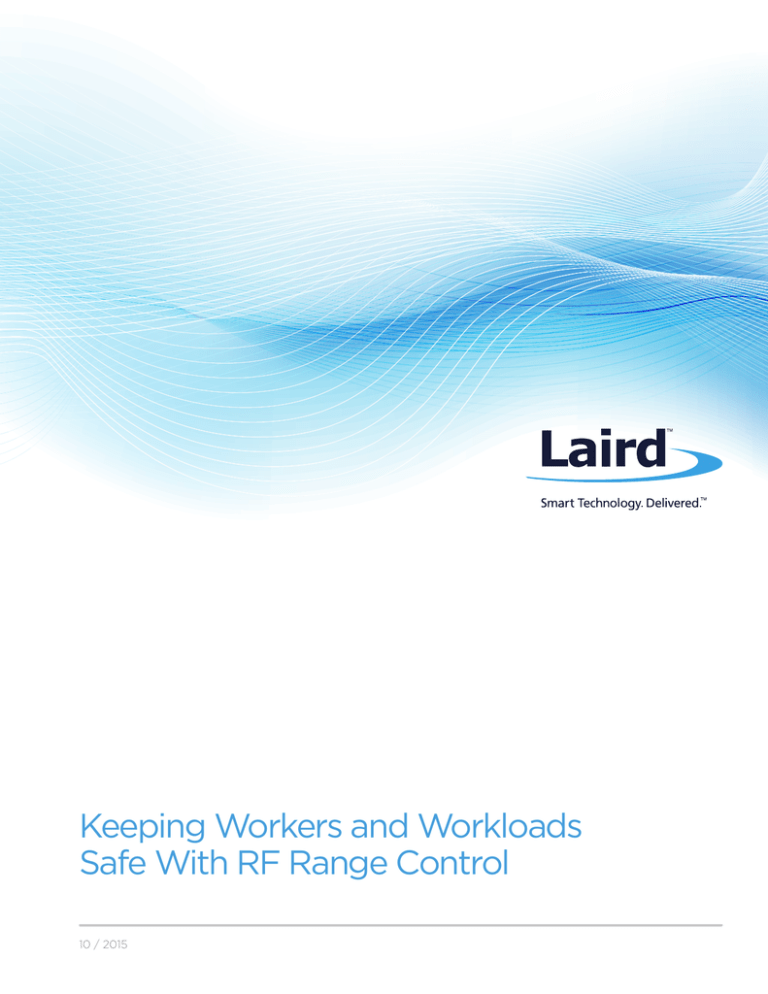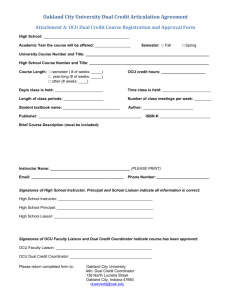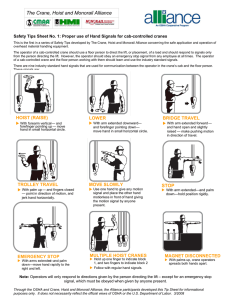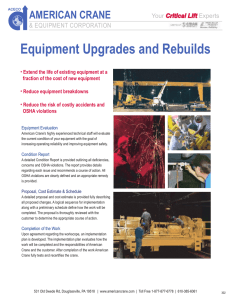
Keeping Workers and Workloads
Safe With RF Range Control
10 / 2015
ABSTRACT
Costly and dangerous equipment accidents and injuries to employees occur in industrial environments —
but are avoidable with strong safety guidelines and the use of equipment that reinforces them. The
Laird RF Range Control feature for the CattronControl™ family of products provides functionality that
ensures operators have the flexibility to do their job while remaining within a safe zone of operations.
Problem
In industrial environments, such as material handling facilities, the use of large overhead cranes is essential
for day-to-day operations. Engineers have the choice to use radio frequency (RF) or infrared (IR) technology
to operate these cranes, and both have their uses. With their ability to move heavy equipment and goods
swiftly and effortlessly, cranes just as easily have the potential to cause injuries to employees and damage to
equipment, particularly if the operator moves outside the line-of-sight zone or if someone tampers with an
operator control unit (OCU) that has been left unattended.
Solution
Unlike RF, IR limits an operator to one location and does
not work when the line of sight between the OCU and
machine is obstructed. This functionality does limit some
of the safety concerns that occur with RF-operated cranes;
however, in many environments, the operator simply cannot
be limited to one location. Furthermore, RF is more reliable
in environments where IR might be blocked by light sources,
such as welding.
While companies put operating rules in place to help
prevent issues such as those, limitations that are built
directly into the equipment add a stronger layer of safety
that is easier to enforce. This is the intent behind the RF
Range Control functionality, which provides reliable closestart and range-limiting functionalities to reduce or eliminate
the risk of unintentional and/or non-visible operation.
This functionality can be added to most cranes currently
being operated with CattronControl MCUs by using a
retrofit kit. Alternatively, companies can include a range
control requirement in specifications for any new crane to
ensure this capability.
2
The Benefits of IR vs. RF:
Each Has Its Uses
Infrared: IR is ideal for situations where an operator
needs to be limited to just one location, in close
proximity to and within directional line of sight to
the crane. IR is very directional and requires the
OCU to be well aligned with a clear line of sight
before close start is possible. Laird does supply IR
start options for these types of applications.
Radio Frequency: RF is ideal for situations
where an operator needs the freedom to move
around while operating the crane, potentially
moving the OCU out of the line of sight of the
antennas mounted on the crane. RF is also not
blocked by light sources, such as welding.
While both can be modified to provide range
limiting, RF does not require the costly add-on
components nor does it have the directional
performance limitations associated with other
IR products that offer similar safety measures.
This means operators are free to move about
the floor, as needed, without signal interruptions
where the line of sight between the OCU and
MCU may be partially broken.
Area of no
operation
Range-limiting Functionality
Range-limiting functionality imposes restrictions
on the maximum distance between an operator
and the crane. Prior to operation, engineers set a
received signal strength (RSS) threshold that cannot
be exceeded for longer than a specified amount of
time. As the operator moves away from the crane,
the RSS becomes weaker until the preset threshold
is exceeded and operation halts. The operator must
then move back into range before he can safely
resume operation of the crane. A typical reliable range
limit is approximately 15 m (50 ft); some intermittent
operation would reach as far as 30 m (100 ft).
Set range
limit point
60 m typ.
30 m typ.
ANTENNA
Area of
reliable operation
Area where
system may be
intermittent
Figure 1:
Illustration of range-limit zone functionality
Close-start Functionality
Close-start functionality requires the operator to
bring the OCU within a preset distance of the crane
to gain control of it. This functionality prevents
anyone from picking up an OCU and inadvertently
operating a crane without being directly underneath
it. A typical reliable close-start point is approximately
3 m (10 ft), but may stretch out to 6 m (20 ft). The
operator (or anyone who might pick up the OCU)
would need to be within this zone to initiate the
motion of it but could then move outside this zone
(optionally staying within the range-limiting zone)
to continue operation. If the OCU is taken outside of
the range-limiting zone or operations are stopped for
a preset amount of time, the operator would need
to move the OCU back into the close-start zone to
resume operation of the crane.
3
Close start
set point
6 m typ.
3 m typ.
ANTENNA
Area where
system can
be started
Area where system
may be started
Figure 2:
Illustration of close-start zone functionality
How It Works
The CattronControl MCU is fitted with equipment that enables it to measure the RSS with a reasonable degree
of accuracy through the use of:
•Multiple flat-panel gain antennas to increase the signal level attenuation vs. distance
•Smart software averaging routines to account for fluctuations in measured signal or distance
By measuring the RSS, the MCU can translate it to the relative distance between it and the associated OCU. This
solution operates in the UHF band, and under ideal conditions the signal decays at a rate equal to the inverse
square law (i.e., if we double the distance between the antennas and the OCU, we get one-quarter the signal).
It’s important to note that UHF can reflect off many surfaces and is attenuated by others, so the signal strength
is an indication of distance, but not a precise measurement. By mounting two gain antennas aimed at the
ground under the crane, we can get a more accurate, though not perfectly precise, average distance reading.
This method ensures that a full signal is always available and the operator’s ability to control the system is
based on preset RSS values, not on the lack of a signal. The use of multiple antennas also ensures that at least
one antenna is within range of the OCU and there are no “dead zones,” an area where the crane could not be
operated once inside that zone.
With the two antennas, active diversity switching and smart software, a close-start setting of 6 m, for example,
may require the operator to move within 3 m to gain control in certain instances, and a range-limiting setting of
15 m may still operate intermittently at 30 m (see Figure 4).
CS
Zone
Building or machine
Flat panel
antenna
Building or machine
Walkway
Figure 3:
Two antennas ensure seamless
operation and eliminate dead zones.
4
Benefits of RF Range Control Functionality
RF operation gives the operator the freedom to move around the shop floor as needed while minimizing
interruptions to the signal between the MCU and OCU from line-of-sight disruptions or light sources. In addition,
the smart software and dual antennas further minimize temporary disruptions to the signal from obstructions,
providing seamless, reliable operations. This combination also improves the ability to approximate the distance
between the MCU and the OCU using the RSS.
Furthermore, the range-control functionality provides two ways to ensure the safety of employees and equipment.
With the close-start functionality, the chance of inadvertent crane operation from a bystander is virtually
eliminated by forcing the OCU to be directly under the crane within a 3–6 m zone to enable the system to be
started. This limitation greatly reduces the chance of an expensive and dangerous accident. With the rangelimiting functionality, the operator can utilize the benefit of RF’s longer range, while still being limited to a basic
zone of safe operations.
Figure 4:
Illustration of signal strength and operating distances
Antenna
Strongest signal
close start zone.
3–6 m
Summary
The Laird RF Range Control feature for CattronControl
systems provides the flexibility for operators to move
around within a well-defined zone, which is necessary in
most industrial environments, while still providing a level
of safety to both employees and equipment. It also provides
a further level of safety through the close-start functionality
by creating a limited zone in which an operator (or anyone
who might pick up the OCU) has to be positioned to activate
the crane.
With the addition of this functionality to all overhead cranes
on-site, costly and dangerous accidents from inadvertent or
blind crane operations are virtually eliminated.
5
Range limit zone region
of reliable control.
Typically 10–15 m
Range limit region of
intermittent control.
Typically 15–30 m
Why Can’t I Simply Cut
My Signal Strength?
Some engineers will attempt to create a similar
range limit by lowering the signal strength
of their OCU, which would then require the
operator to remain closer to the crane to
maintain a signal. In theory, this does limit the
operating range of the OCU; however, it also
leads to poor performance and nuisance trips
that will affect operational efficiency.
Contact our sales staff to learn how Laird Wireless Automation and
Control Solutions can help you streamline your operations today.
www.lairdtech.com
www.lairdtech.com/RFWP
United States +1.234.806.0018
Canada +1.514.908.1659
Europe +49.2161.6363.0
Asia +86.21.3120.0188
Latin America +55.19.3243.7803
Any information furnished by Laird and its agents ia believed to be accurate and reliable. All specifications are subject to change without notice. Responsibility for the use and
application of Laird Materials rests with the end user, since Laird and its agents cannot be aware of all potential uses. Laird makes no warranties as to the fitness, merchantability
or suitability of any Laird materials or products for any specific or general uses. Laird, Laird Technologies, Inc. or any of its affiliates or agents shall not be liable for incidental or
consequential damages of any kind. All Laird products are sold pursuant to the Laird Technologies’ Terms and Conditions of sale in effect from time to time, a copy of which will be
furnished upon request. © Copyright 2015 Laird Technologies, Inc. All Rights Reserved. Laird, Laird Technologies, the Laird Technologies Logo, and other marks are trademarks or
registered trademarks of Laird Technologies, Inc. or an affiliate company thereof. Other product or service names may be the property of third parties. Nothing herein provides a
license under any Laird or any third party intellectual property rights.
WACS-WP-IND-1015-RFRangeLimit







